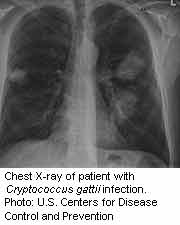
THURSDAY, July 22 (HealthDay News) — Cryptococcus gattii — an airborne fungus that can cause life-threatening illness — is an emerging infection in the Pacific Northwest, U.S. health officials said Thursday.
While C. gattii infections are rare — only 60 cases have been reported since 2004 — they can be severe and even fatal, researchers at the U.S. Centers for Disease Control and Prevention report in the July 23 issue of the Morbidity and Mortality Weekly Report.
“C. gattii is still rare so we don’t want people to panic or to misunderstand the risk of infection, but it is serious,” said co-author Julie Harris, of CDC’s National Center for Zoonotic, Vector-Borne, and Enteric Diseases.
Harris explained that people get the infection by breathing in the spores of the fungus, which live in the environment and are usually found in the bark of certain trees and the surrounding ground.
C. gattii infection causes a prolonged cough, shortness of breath, headache, fever, weight loss, and, in some patients, a stiff neck, according to Harris. The fungal infection is not contagious among people, she added.
Symptoms can take months to develop after exposure, with the median time being six to seven months, and incubation periods as short as eight weeks and as long as 13 months.
Of the 60 reported U.S. cases of C. gattii since 2004, 43 were in Oregon, 15 in Washington and one each in California and Idaho, the report noted.
Among the 47 patients whose medical information was known, 81 percent had another underlying disease — including three patients with HIV — that could have made them susceptible to C. gattii infection, the report indicated.
Nine of the patients who were tracked after becoming infected (20 percent) died due to their infection, and six others died with the infection. But only two of the nine who died due to C. gattii had no predisposing condition, the findings showed.
Harris noted that the total number of cases of C. gattii infection is unknown, because only the more severe cases tend to be reported. But she expects to see more mild cases as people become aware of the infection.
“We don’t know at this point what the true case fatality rate is,” Harris said. “As with any new disease, what you usually see is that mild cases go undetected, so probably the case fatality rate is going to be lower than what we are seeing right now.”
Treatment for C. gattii consists of six to eight weeks of intravenous anti-fungal medications, followed by six months or more of oral fluconazole and it “is not always a pleasant treatment,” Harris added.
At the moment, C. gattii appears to be confined to the Pacific Northwest. It could spread, but Harris said that might not happen because “fungi need very special environmental conditions to survive and to propagate.”
Why this infection — typically a tropical disease — is now cropping up in the United States is not known, Harris stated. It is endemic to Australia and Papua New Guinea and has been seen in northern Africa, Asia, Brazil, Columbia and parts of the Mediterranean, she said.
However, the type of C. gattii seen in the United States is uncommon in other parts of the globe, according to the report, which noted that one Pacific Northwest subtype has never been seen before.
The CDC is also aware of 52 cases of infection among animals.
“It can be fatal to animals. Animals are closer to the ground, they’re sniffing around, so we think they are probably more susceptible to infection than humans,” Harris said.
Infectious disease expert Dr. Marc Siegel, an associate professor of medicine at New York University, said while the number of infections is small, C. gattii is an emerging infection that needs to be taken seriously.
“We never know which emerging strain of a bacteria or fungus is going to be the one we have to worry about,” Siegel said. “This one, which is becoming hardier and more drug-resistant, is one that needs to be on our radar screen,” he said.
More information
For more information on C. gattii, visit the Oregon Department of Human Services.

